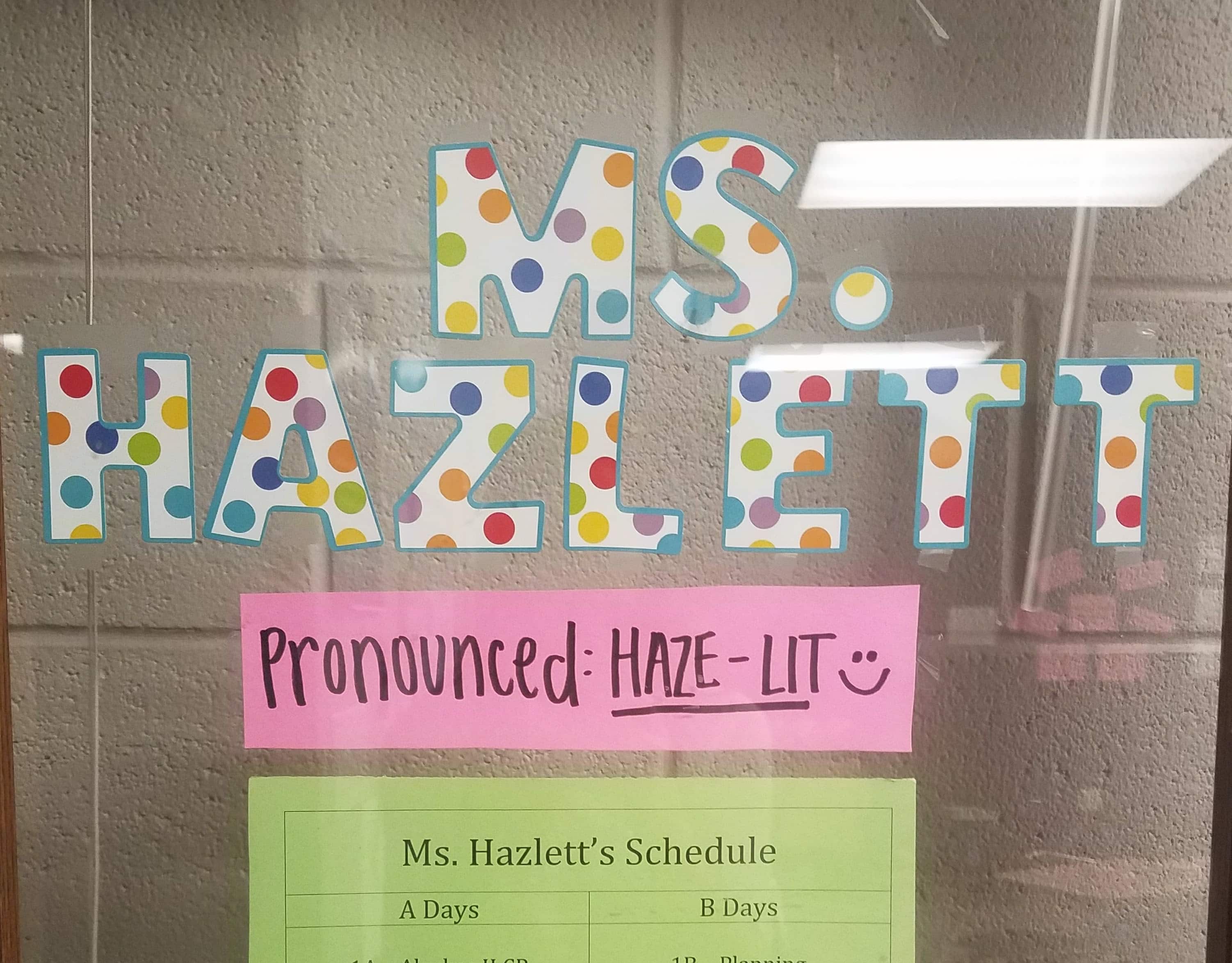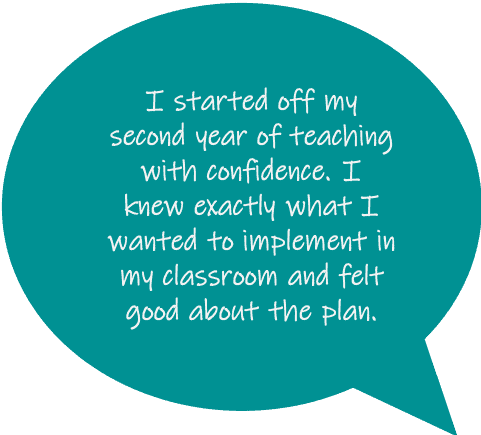by Madalyn Hazlett
Dreher High School Mathematics Teacher
At the end of my first year of teaching, I was asked to give one positive story that came from that school year.
I could not come up with a single one.
That shocked me.

Until then, I had not realized how much I struggled my first year. I could not think of one positive moment. The entirely new world I got thrown into my first year was often overwhelming, exhausting, and emotionally taxing. I will say, although I did not cry every day like some veteran teachers shared with me about their first year, I cringe when I think about some horror stories of that year.
How do you respond to an email from a parent who says you do not care about students who are in special education (when you have a brother with autism)? What are you supposed to do when you are in the middle of teaching and realize an “off limits” cell phone is interrupting learning? Cause a huge disruption by stopping the lesson and confiscating? Ignore it, to the benefit of other students not missing instruction, but hurting the student who is not paying attention? What about group chats your students create where they send one another pictures of homework assignments? How do you stop a group of kids from short-cutting their learning when they are not even in view? Challenging emails from parents, meetings that took away valuable (and never enough) planning time, learning how to implement IEPs properly, controlling the phones in my classroom, all topped off by the content I had to plan for and teach, I was definitely a different, more exhausted, unpleasant, troll-version of myself.
Hello, Carolina TIP (Teacher Induction Program).
The University of South Carolina’s College of Education decided that they should offer more supports “bridging the gap” between studying to be an educator and actually being one. Most anyone who has been in education long-term will tell you that the first few years of teaching are the most difficult. Carolina TIP was designed to address those difficulties and help teachers transition more smoothly from being students of teaching to being teachers of students.
I remember seeing an email about joining TIP and thinking, sure, I would be stupid not to get all the help I can! I knew there would be a time commitment, a few Saturdays to give up and a few meetings to add to my calendar, but if it helped me get my classroom in order, it would be worth it.
On the other hand, I did have my doubts about the program. I think most educators have been to professional development where their “attention” becomes about constantly watching the clock and fidgeting, thinking about the pile of work left at their desks. Fortunately, these supports got my undivided attention. We talked through much needed classroom management strategies during our first session (not by coincidence, I learned), and I have never been to a professional development so engaging and useful. I was floored by how many of my fellow TIP participants were jotting down notes along with me and trying to figure out how to best take the ideas back into our classrooms.
One compelling experience with TIP was a lesson modeled for us on the word floccinaucinihilipilification. The lesson was designed to help us learn how to best remember a word that none of us had ever heard of before or had ever even deigned to attempt pronouncing. To this day, I still remember how to pronounce the word and what it means. So not only were we given suggestions on management and instruction, we were also given the chance to see this teaching strategy modeled very effectively!

There’s more to Carolina TIP than a few Saturday sessions on classroom management and instructional strategies. My assigned mentor, Nicole Skeen, visited my classroom to observe and meet with me. The important thing about this mentor relationship is that she was not there to give me evaluative feedback, unless I wanted it. She was there to listen, offer suggestions for things she saw (when asked), and generally support me. The very first meeting we had she started by asking how much time I was willing to let her stay and then setting a timer. I was floored by that; as a former teacher, she understood that my time was extremely valuable, and she respected that.
Candidly, looking back at my first year, I remember very little. It just seemed like a whirlwind of chaos interspersed with some terrible moments. I do remember, however, ending my first year thinking that I could count on my hand the number of people who believed that I was (or would be) a good educator. One of the few people who did was Nicole.
My last week of school, I asked her to come help me figure out how I could improve the start of my next year. We met for several hours that week and the next talking through exactly what I wanted my class to look like and how I wanted to manage my community of learners. I started by writing down everything I wanted, and she helped me figure out plans to implement it. The planning for year two was half the battle. The other half was having someone there to support me and tell me that they believed in me and would provide encouragement whenever I needed it. There is serious power in knowing someone is rooting for you and has skills to help you succeed.
I started off my second year of teaching with confidence. I knew exactly what I wanted to implement in my classroom and felt good about the plan. Throughout this second year, I have realized there are some things here-and-there that I need to tweak to get my classroom management where I want it to be for next year (if not sooner), but I no longer feel like I am drowning in the impossibility of teaching a classroom of 30 students. Just as importantly, I started participating more at our school outside of my classroom duties. I am the head of our math team, work on the literacy team, attend textbook caravans and showcases, co-sponsor our school’s new ESports team, and co-chair the Sunshine committee to support employee morale! I would never have felt comfortable becoming more active in my school community had I not felt comfortable with my own classroom.
 I taught a number of the same students I had taught during my first year thanks to a new course that most of them progressed to. I remember on my first day of year two, as I was going over new rules and procedures with my classes, most of my former students were exchanging surprised looks over how much more structure I was putting in place. However, all of these kids progressed at a faster pace and did much better in the content this year. Their struggles with math seemed to have dissipated as did some of my struggles. I was able to connect with my students more deeply, understanding better how they were doing individually, and being more aware of what particular concepts were most challenging and how they learned best. This past year was more about what they needed because TIP gave me more of what I needed.
I taught a number of the same students I had taught during my first year thanks to a new course that most of them progressed to. I remember on my first day of year two, as I was going over new rules and procedures with my classes, most of my former students were exchanging surprised looks over how much more structure I was putting in place. However, all of these kids progressed at a faster pace and did much better in the content this year. Their struggles with math seemed to have dissipated as did some of my struggles. I was able to connect with my students more deeply, understanding better how they were doing individually, and being more aware of what particular concepts were most challenging and how they learned best. This past year was more about what they needed because TIP gave me more of what I needed.
I was making announcements one day, and I cannot even tell you what I was going to say, but I must have started with “So since last year, most of you know that I am…,” and one of my students, without any hint of sarcasm blurted out, “…a better teacher!” I stopped, looked at him, and said, “Yes, that too.” This was a remarkable moment for me. Seeing my practice advancing through the eyes of a student was validating and invigorating.
My TIP colleagues have different versions of this story, all leading to the same positive result: returning to the classroom in year two more prepared and more confident. While every teacher is different, and every story is different, Carolina TIP is designed to tailor its support to those unique challenges, not be a one-size-fits-all program.
I still cringe when I think back to my first classroom observation from Nicole, but I have progressed and changed so much since then that I hardly recognize “that teacher”! I will never forget what Nicole said to me after the students left that first day she came to visit: “I’m proud of you.” Her belief in me and my ability as an educator not only kept me in the classroom, it also convinced me to embrace how overcoming my challenges would be worth the struggle. That’s a lesson I continue to pass on to my students every day.
Read Madalyn’s second story about From Novice to Accomplished: Reflections from a CarolinaTIP Alumna